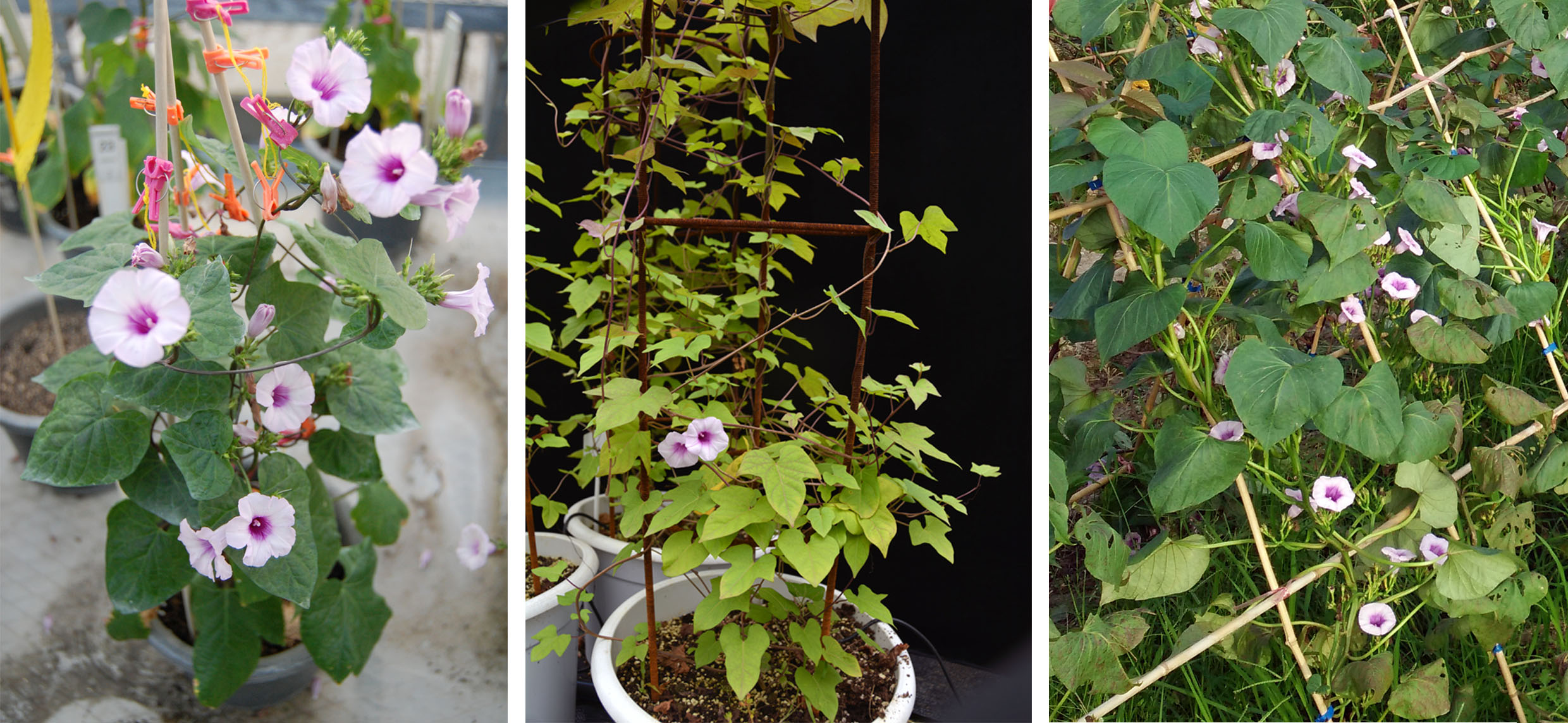

Sweet potato tetraploid ancestral species (left), diploid ancestral species (middle), and sweet potato (right) plants.
·This study identified the ancestral species of sweet potato and discovered the genes involved in the domestication process of sweet potato. Subsequently, it is expected to improve sweet potato through hybridization, gene editing and other methods.
Humans have eaten the natural genetically modified crop sweet potato, also known as sweet potato, for almost 10,000 years. It is an important food crop, but its origin has always been a mystery, and the domestication process is also unclear.
This has led to difficulties in the fields of sweet potato genetics, genomics and breeding, restricting the improvement of sweet potato varieties and the use of closely related wild species.
Recently, a team of scientists from China, Belgium and Germany published a research paper in the international academic journal Molecular Plant, identifying the diploid and tetraploid ancestral species of sweet potato. The research shows that sweet potato is composed of two ancestral species. Reciprocal cross and genome doubling. After the formation of sweet potato, gene exchange between subgenomes occurred in approximately 50% of the region.
The title of the paper is "Haplotype-based phylogenetic analysis and population genomics uncover the origin and domestication of sweetpotato."

In August 2017, scientists from Shanghai Chenshan Botanical Garden and other institutions jointly published a paper taking the lead in analyzing the sweet potato genome.
Revealing the process of forming sweet potatoes from ancestral seeds is expected to accelerate the breeding and improvement of sweet potatoes
Closely related wild species have high genetic diversity and resistance advantages and are an important resource bank for crop improvement. The genes for excellent traits of ancestral species can be introduced into crops through hybridization or gene editing. Previously, after decades of efforts, scientists hoped to breed artificial hybrid hexaploid sweet potatoes through hybridization of closely related wild species, but they have not yet made ideal progress. The biggest limitation is that the ancestral species and origin of sweet potato are not yet clear, so it is impossible to artificially simulate the formation of sweet potato.
The latest published research paper mentioned above stated that the diploid ancestor species of sweet potato may be diploid equatorial sweet potato, and its tetraploid ancestor species is tetraploid sweet potato.
By comparing the genetic diversity between sweetpotato and two ancestral species populations, the researchers found that many important functional genes were selected by natural selection and artificial domestication. These functional genes include root formation, maintenance of genome stability, biological resistance, and sugar transport. , potassium absorption.
Associate researcher Yan Mengxiao of Shanghai Chenshan Botanical Garden and associate researcher Li Ming of the School of Life Sciences of Chongqing Normal University are the co-first authors of the paper.
Yan Mengxiao told The Paper that the identification of the ancestral species of sweet potato and the analysis of the domestication mechanism by researchers will help scientists understand the mechanism by which the ancestral species formed sweet potatoes, giving us the opportunity to repeat this process in the laboratory, which can accelerate the development of sweet potatoes. Breeding and improvement.
Yan Mengxiao further explained that first of all, this research result identified the diploid and tetraploid ancestors of sweet potato based on multiple genetic evidences, and determined the formation method of sweet potato, which laid an important foundation for artificial hybridization to produce new sweet potatoes. theoretical basis. Secondly, this study discovered many genes involved in the domestication process of sweet potatoes. These genetic resources can be used to further improve sweet potatoes and other root crops through hybridization, gene editing, etc.
Natural genetically modified fragments help find the ancestral species of sweet potato
Regarding the innovativeness of this research, Yan Mengxiao said that sweet potato is a natural genetically modified crop, and its genome contains T-DNA sequences from Agrobacterium tumefaciens. This study cleverly used these T-DNA sequences as molecular markers to quickly and accurately identify the ancestral species of sweet potato. Secondly, because the relationship between sweet potato and its ancestral species is very close, conventional methods are difficult to accurately analyze. This study proposes a new method for phylogenetic analysis using polyploid homologous haplotypes. This method is also expected to be applied to analyze the genetic relationships between other polyploid species and assist in the analysis of the origins of other polyploid crops.
In addition, the researchers broke through the thinking limitations of traditional sweet potato origin theories, combined multiple genetic evidences, and proposed a new origin hypothesis to reasonably explain the subgenome and maternal origin of sweet potato.
According to previous reports by The Paper, in August 2017, scientists from Shanghai Chenshan Botanical Garden and other institutions jointly published a paper taking the lead in analyzing the sweet potato genome. The relevant paper was published online in the international academic journal Nature Plants. The newly published research paper is a further development of previous research.
Latest published research papers:
https://www.cell.com/molecular-plant/pdf/S1674-2052(23)00413-6.pdf?_returnURL=https%3A%2F%2Flinkinghub.elsevier.com%2Fretrieve%2Fpii%2FS1674205223004136%3Fshowall% 3Dtrue
Relevant research papers published in 2017:
https://www.nature.com/articles/s41477-017-0002-z